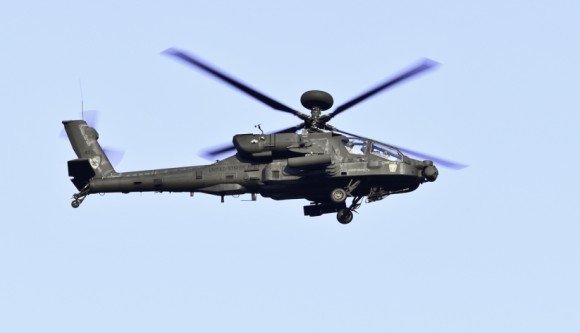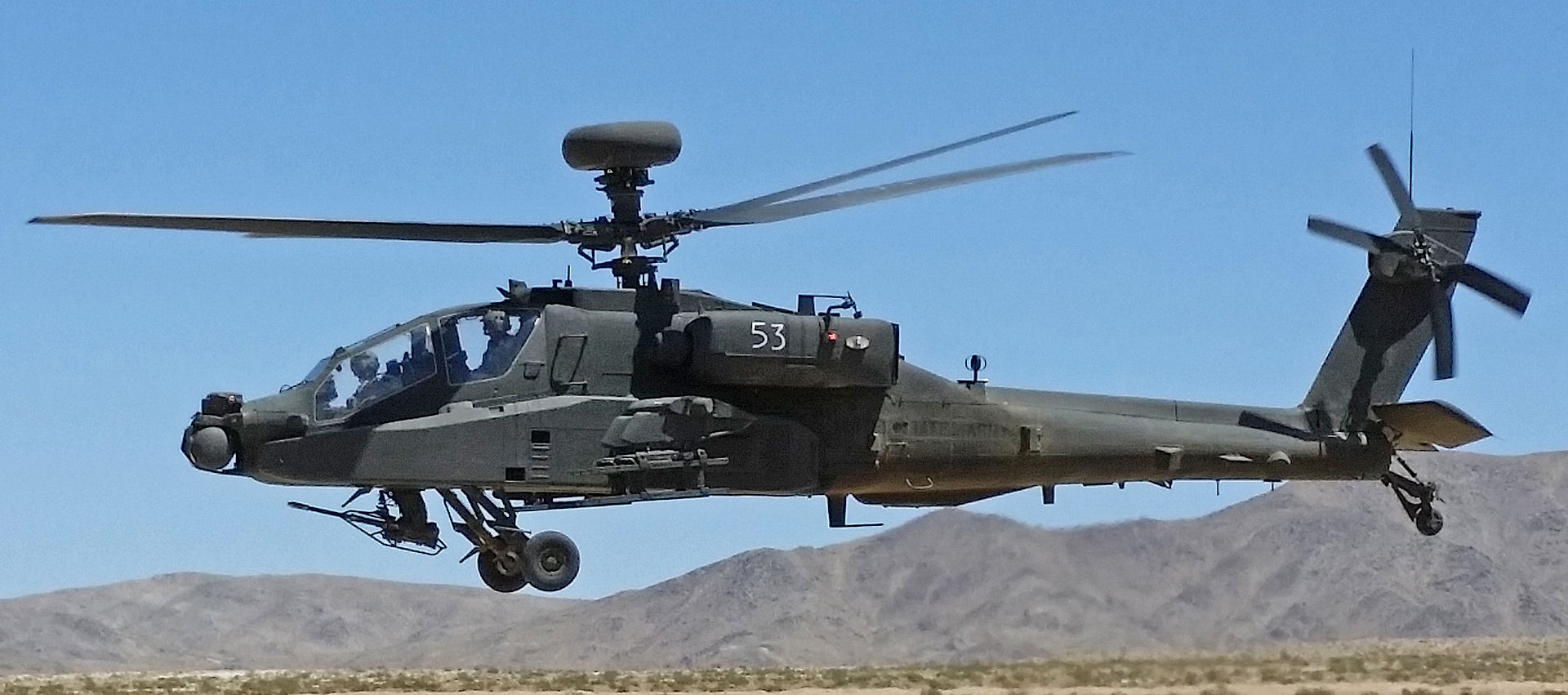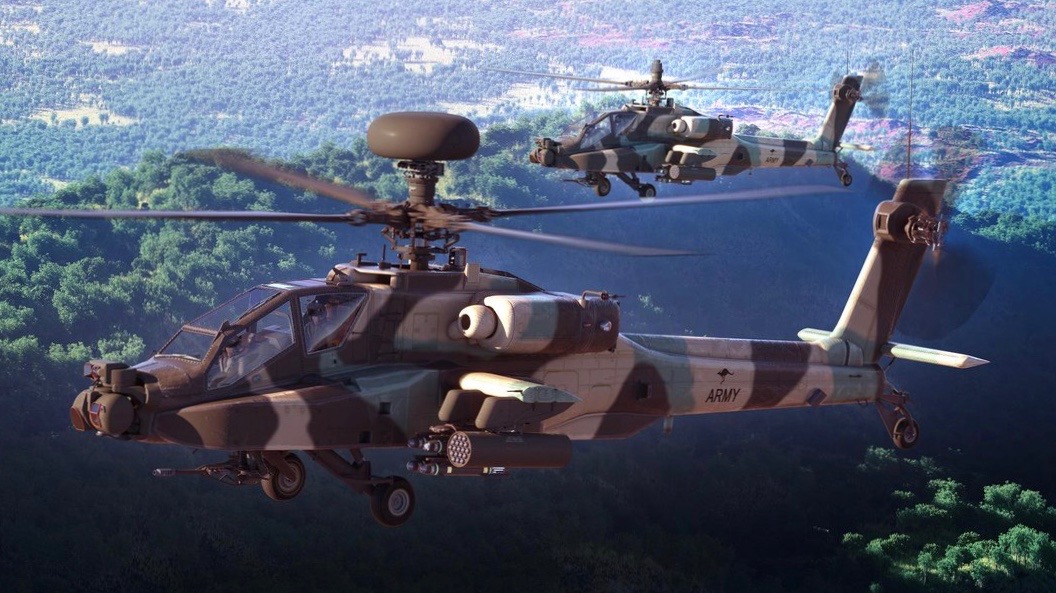"Apache Guardian Developing New Capabilities" [INTERVIEW]

A total of 791 AH-64Es are to be procured for the US military. The variant currently in production is version 6, but Boeing and the US Army are planning to upgrade them further. Further existing and emerging solutions will be incorporated into this aforementioned modular architecture. Today, much of the new technology that is rapidly growing and evolving is software - as George „Adam” Hodges, Capture Team Lead for Vertical Lift International Sales, Boeing Defense, Space & Security told Defence24.pl in an interview.
Juliusz Sabak, Defence24.pl: Poland is currently looking for attack helicopter in the Kruk program. One of the candidates is the Boeing-produced Apache, available via Foreign Military Sales (FMS) procedure, acquired from the US government. Prior to your position at Boeing, your service in the US Army was associated with Apache helicopters and the development of this system, how did it progress?
George "Adam" Hodges, Capture Team Lead for Vertical Lift International Sales, Boeing Defense, Space & Security: I was exceptionally fortunate to be an Apache helicopter pilot. I started my service on the AH-64A, the earliest versions, and ended up on the AH-64E, the latest digital model. This gives me a great understanding of how the system works and how it has been continuously modernized and developed over the years to meet new and emerging threats.
I served four combat tours during my service, two each in Iraq and Afghanistan. The last was in 2016, when I commanded an Apache helicopter Battalion in Iraq. Before I left the Army, I was assigned to work at the Pentagon, where I was responsible for upgrading AH-64 Apache systems for the US Army Department of Land Forces. This gave me an opportunity to see how the Apache modernization plans looked from a broader military perspective. I am also fortunate to work for Boeing because I am still involved with the Apache and in the continuous modernization process of the system, but on the industrial side. The Apache still has a long future ahead.
I was stationed in Europe twice during my military service and I can tell you the Apache is perfectly suited to the European environment – it was originally designed to operate in Europe. I look forward to visiting Poland when the global health situation improves.
And what can be said today about the talks on the possible sale of Apache to Poland?
Despite all of the recent challenges around the world, both the Polish and US Government have worked together to strengthen the alliance in response to regional security threats. As part of the August 2020 agreement, the U.S. presence in Poland will increase, which will include a permanent rotating presence of the U.S. Army Aviation Brigade Command in Powidz.
This also means that the US Army Apache attack helicopter battalion will be present in Poland. As a result, and because the US Army operates the Apache, the Polish Army will have more opportunities than ever before to jointly train and improve the level of interoperability with US Army helicopter operators and crews.
I think this could be of significant importance for the Polish government when it makes decisions on the KRUK attack helicopter program. Answers to more detailed questions are reserved for the Armament Inspectorate.
The assumption of the Ministry of Defense and the Polish government is to create national industrial capabilities during the realization of modernization programs. What does the Boeing proposal look like in this respect?
Our strategy is continuous cooperation with Poland and creating conditions for long-term cooperation, which generates benefits for all parties involved. Boeing employs more than 600 persons in Poland and we keep extending our partnerships with Polish companies. As an example, we have entered into a number of agreements with industry in this regard. In 2015, Boeing and PGZ signed a Memorandum of Understanding (MoU) for broad cooperation on Poland’s defense modernization efforts. Boeing and PGZ updated this MoU in-2018 to specifically include cooperation on Apache helicopters. Additionally, Boeing signed a Letter of Intent (LoI) in 2016, which provides for much broader cooperation with PGZ on the KRUK program and beyond the KRUK program. A good example is WZL-2, which already services Boeing aircraft and is part of Boeing’s global supply chain. WZL-2 meets our high quality standards, delivery and other standards. As a result, WZL-2 Bydgoscz achieved the Silver Supplier Award for Supplier Excellence.
We will continue to work with the Ministry of Defense and the Polish industry to develop cooperation in the area of aviation and defense. For Poland the goal is certainly to build independence in these areas. This is especially true for the development, maintenance and modernization support as well as the development of unique Polish systems for aircraft such as Apache. Boeing is ready to support the strong capabilities of Polish industry by providing opportunity to integrate it into its global supply chains. The broad scope of Boeing’s business provides great opportunities to collaborate and maximize benefits to Polish industry and to Boeing.
Boeing has been active in Poland in the civil aviation sector for years, working with, among others, the Aviation Valley cluster. Boeing has an extensive supply chain in Poland with more than 40 entities. That's about half a billion dollars over the last 10 years alone. Today, almost every commercial Boeing airplane that flies around the world has components and systems made in Poland.

I would like to look a little bit into the future. In the perspective, the existing US Army helicopters will be replaced by new platforms developed under the Future Vertical Lift project. It can be expected that the US allies will also opt for these machines. To what extent is Boeing involved in FVL?
Actually the Future Vertical Lift is a hot topic. Boeing is seriously involved in its development, primarily through the DEFIANT X helicopter project, which is being developed under the Future Long Range Assault Aircraft (FLRAA) multi-role helicopter program. The US Army has also contracted to develop the Future Attack Reconnaissance Aircraft (FARA) helicopter.
If you’d like to discuss more about the DEFIANT X and any opportunities that exist, we can connect you with the proper Boeing representative.
So let's get back to the present. Obviously 2020 has been COVID-19, how has the pandemic affected production at Boeing's Apache delivery facilities?
The decisions we made had the health and safety of our employees first and foremost in mind. We continually analyzed the impact of the virus on our operations and adapted measures to the current situation. As we faced new challenges, we made it our goal to meet our commitments to our customers.
In 2020, despite the challenges, production continued at the Mesa plant, where the Apache is built. As a result, the five hundredth copy of the AH-64E Apache helicopter was delivered. The total production of machines of all versions exceeded 2500 units. Last year we completed the deliveries of Apache helicopters to the Indian Air Force as planned.
The first AH-64E Apache arrived in the UK in November. With reference to this, slightly different, British version I wanted to ask about missiles. In Poland, we still have not selected a target missile for helicopters and drones in the Karabela program. One of the main competitors here are MBDA with the Brimstone missile and Rafael with the Spike missile family, which in one of its variants are already produced in Poland. Hence the question - what if Poland will expect Apache with missiles like Spike or Brimstone?
This is a very interesting question. The standard Apache armament configuration in the US Army consists of a 30 mm cannon, Hellfire guided missiles, 70 mm rockets and optional Stinger air-to-air missiles. The British configuration differs very slightly from the U.S. configuration. If Poland requires integration of Spike missiles, Brimstone missiles, or other armaments that are not part of this standard U.S.. Army configuration at this time, that will obviously be part of the FMS process. Integration of other, non-U.S. armaments is possible, but it could involve additional costs.
When we engage Polish decision makers, we often emphasize that the best way to get the Apache at an affordable price and reduce operating costs is to purchase the Apache in the U.S. Army common configuration. Such a solution ensures the most cost-effective and the fastest delivery.
In your opinion, it would potentially be best to buy Apaches in the standard US Army configuration for fast and economically optimized delivery, and only then consider their possible retrofitting with new weapons?
Of course. Integration of country-specific systems is possible. If Poland decides on additional types of armaments then it will be feasible. Other FMS customers have already done this in the past. It is possible, but it could involve additional costs due to technical changes.
While we are on export varieties, I would like to ask about something else. The notification issued in the FMS program shows that, for example, helicopters intended for Kuwait have a system for cooperation with drones marked MUM-T International. What are the differences between this variant and the MUM-T used on U.S. machines?
The MUM-T system is part of our offer for Poland. The details of what is available for specific customers under the MUM-T capability due to their sensitive nature are a proprietary part of the intergovernmental negotiations under the FMS process. All I can say is that MUM-T gives Apache a significant increase in capability.
I myself have enjoyed the possibilities of manned and unmanned machines working together in a combat environment. I saw it in action back in the early stages, during operations against the Taliban in
2011 in Afghanistan. 10 years ago this solution was not yet called MUM-T and was only tested in combat. In contrast, I was able to see the rapid development that Apache cooperation with drones underwent in Iraq during multiple engagements with ISIS in 2016 on AH-64D helicopters. Over the next four years, change happened even faster as everyone came to appreciate the advantage that drones provide. The MUM-T comes up in every FMS negotiation, whether with Poland, Australia, or Kuwait.
What does the use of MUM-T look like from an Apache helicopter pilot's perspective?
I can't go into details, but I can say that MUM-T allows the "E" version of the AH-64 helicopter to communicate with any unmanned platforms. I'm referring to the tremendous capabilities that come from using sensor networks, unmanned platforms and their weaponry on the modern battlefield. Manned-Unmanned Teaming allows for real-time data exchange between an unmanned platform and an Apache helicopter, which multiplies operational capabilities tremendously.
I understand we can't go too deeply into this topic, so I'll move on to another. The year 2021 starts very well - with Australia's decision to purchase 29 new AH-64E Apache. What are the prospects going forward?
Boeing appreciates the confidence of the Australian government in its decision to select the proven, reliable and affordable AH-64E Apache aircraft. We understand the importance of this program to regional security and stand ready to support the Australian and U.S. governments.
We welcome the strong interest in the "E" version of the Apache helicopter. The US Army will also be replacing more Apache "D" with "E" this year. Foreign sales are, of course, a complex and multi-step process involving the State Department and Congress. This means that questions about the details should be directed to the U.S. government, as it is responsible for implementing this procedure.

There are currently more than 1,200 Apache helicopters in use worldwide, with more than 500 representing the latest digital "E" model. Outside the US, they are the primary attack helicopters in sixteen countries around the world. Multiple other countries are currently expressing interest in joining this fleet.
This large number of global users provides an opportunity for collaboration and joint operations. It also provides the basis for maintaining and developing a huge network of operational support and technical cooperation. This is one of the reasons why Apache is so often chosen. But its capabilities remain key, especially its fire control radar and radar interferometer, Link 16, and Manned-Unmanned Teaming, which we just talked about. And we can't forget the dual optoelectronic sensor system located in the nose of the machine.
And what about the price and operating costs?
To answer your question about Australia or Kuwait, I mentioned that the Apache regularly wins tenders because it is the most proven, reliable and advanced attack helicopter in the world. Additionally, it guarantees lower life-cycle costs than the competition. The Apache modernization plan is funded by the
American government. This gives customers like Poland the opportunity to take advantage of economies of scale, which translates into a favorable price at the time of purchase and years of savings over the life-cycle of the machines.
I understand that this is your perspective for today. And what about the future? Earlier it was said that Apaches are expected to remain in service until at least the end of the 2050s.
Yes, the US Army plans to use Apache helicopters until the middle of the 21st century and even longer. Today, the US Army is somewhere in the middle of upgrading its AH-64D fleet to the "E" model standard. A total of 791 AH-64Es are to be procured for the US military. The variant currently in production is version 6, but Boeing and the US Army are planning to upgrade them further. Further existing and emerging solutions will be incorporated into this aforementioned modular architecture. Today, much of the new technology that is rapidly growing and evolving is software. The Version 6 of the AH64E provides the capability to rapidly introduce and leverage new solutions. Apache will be the principle Attack Helicopter for the US Army and International Apache operators for decades to come.
The AH-64E Version 6 is the first version adapted to the new JAGM missiles that are to replace the Hellfire missiles. What does their integration look like now?
JAGM is actually going to be the standard in the US Army in the future. The Apache will be fully integrated with these missiles. JAGM combines in one missile many functionalities that different versions of the AGM-114 Hellfire had so far. It is currently being tested by the US Army to confirm full compliance, but eventually all Apaches will be adapted to use this type of armament.
When could Poland get the first Apaches if we ordered them in 2021?
I shouldn't speculate on this, but delivery is possible much sooner than most might expect. The details of delivery, including its schedule, are a matter of a G2G agreement between the Polish and U.S. governments.
The US Army plans to purchase Apache helicopters through the end of this decade. The best option, which gives a chance for quick delivery, is to choose the standard US Army configuration under this procurement.
We have the capability, but Poland must first negotiate with the U.S. Government on the exact specifications, equipment, delivery time and training, in accordance with the FMS procedure. We are ready and willing to provide all information and support to the Polish Ministry of Defense in this process, if necessary.
Thank you for the interview.
